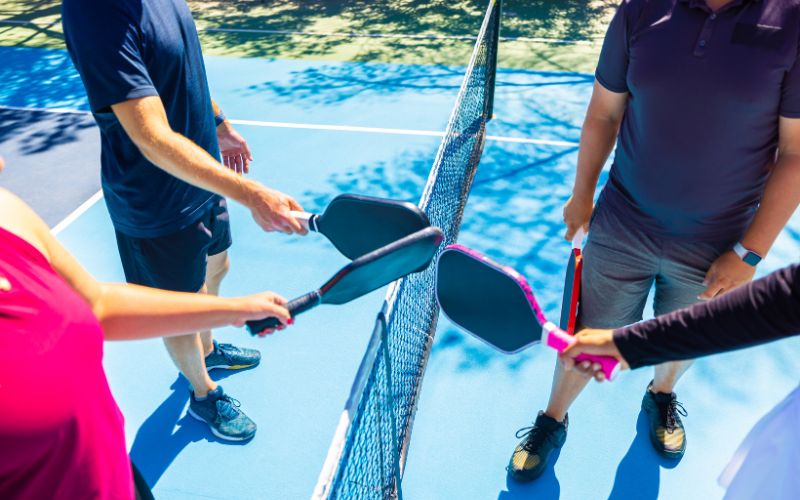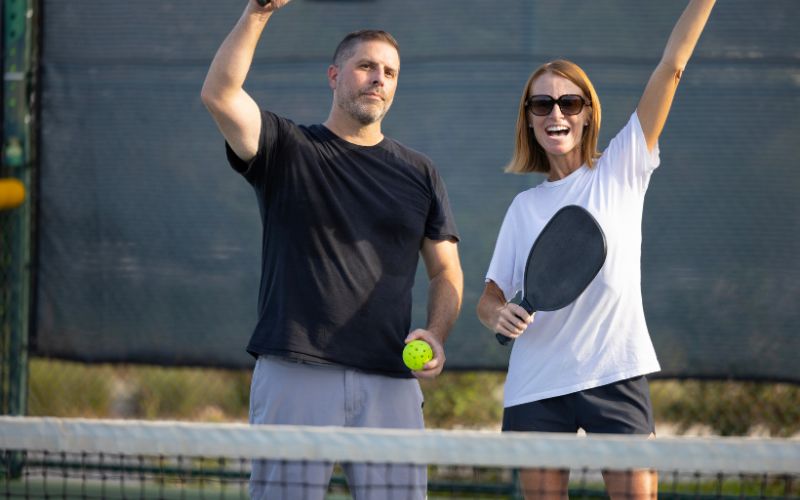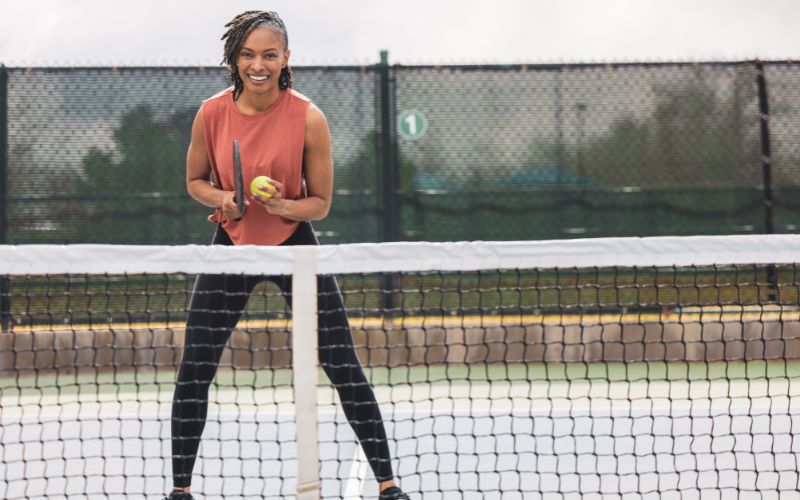Pickleball has gained immense popularity in recent years, becoming one of the fastest-growing racket sports globally. Its unique blend of tennis, ping pong, and badminton elements has captivated players of all ages. Whether you’re a seasoned player or a newcomer to the game, incorporating a targeted strength training routine into your regimen can significantly enhance your performance on the pickleball court. In this article, we’ll explore a comprehensive pickleball workout designed to improve your overall fitness, with a particular focus on enhancing upper body strength, lower body stability, and injury prevention.
Understanding the Importance of Strength Training for Pickleball Players
The Positive Impact of Strength Training on Pickleball Performance
Pickleball is a demanding sport that requires a combination of power, agility, and endurance. Strength training plays a crucial role in developing the physical attributes needed to excel on the court. By targeting major muscle groups and improving overall body strength, players can expect a positive impact on their gameplay.
Injury Prevention Through Strength Training
Injuries are an unfortunate reality in any sport, and pickleball is no exception. Incorporating specific strength training exercises into your routine can contribute to injury prevention by enhancing the resilience of muscles and joints. This becomes especially important when engaging in the quick, dynamic movements required during a pickleball game.
The Pickleball Workout
1. Multiple Planes Lunges
Versatile Lunges Across Multiple Planes Lunges stand out as a remarkable exercise for athletes, offering versatility in terms of loading and the variety of planes of movement and body positions that can be addressed.
Given the diverse range of multi-directional movements and positions involved in pickleball, incorporating lunges in various directions is sure to contribute positively to your on-court mobility, strength, and balance.
2. Multi-Directional Single-Leg Jumps Over Mini Hurdles
Engaging in single-leg countermovement jumps proves to be an excellent workout for athletes, especially those involved in pickleball. This exercise effectively targets stability in the ankle, knee, and hip, emphasizing balance and power. Regular incorporation of these jumps into your routine will contribute significantly to on-court balance and mobility.
To execute this exercise, utilize 6” mini hurdles and initiate the process with linear jumps. Begin by performing a countermovement, involving a hinge at the hips with a slight knee bend on the working leg. Jump over the hurdle or cone and land with precision, aiming for a landing position identical to a freeze-frame picture of the bottom of your countermovement. Stand tall, repeat the countermovement action, and proceed to jump over the remaining hurdles.
Extend this technique to lateral jumps, ensuring that your shoulders and hips remain square without rotation in the direction of movement. For beginners, cones or markers on the ground can be used as entry-level progressions. Regular practice of these multi-planar mini hurdle single-leg countermovement jumps will undoubtedly enhance your stability, balance, and power, translating to improved performance on the pickleball court.
3. Trap Bar Deadlift: A Comprehensive Strength-Building Exercise
The trap bar deadlift stands out as an excellent workout for enhancing overall body strength, with a specific focus on the glutes, hamstrings, lower back, and core. Its user-friendly nature, attributed to the position of the handles, makes it an ideal exercise for athletes of varying experience levels.
In the starting position, ensure straight arms, with elbows positioned outside the knees and the back at a 45-degree angle. It’s important to note that the athlete should not assume a full squat position at this stage.
To initiate the movement, press your feet firmly through the floor while maintaining core and trunk stability. The shoulders and hips should move at a consistent rate throughout this phase.
Upon reaching the finishing position, emphasize squeezing your glutes and maintaining a braced core, aiming to stand as tall as possible. It’s crucial to avoid thrusting the hips forward excessively at the conclusion of the movement.
When lowering the bar back down to the floor, maintain a synchronized movement of the shoulders and hips. This controlled descent ensures a balanced and effective execution of the trap bar deadlift, contributing to the development of total body strength.
4. Kettlebell Swings: A Dynamic Exercise for the Lower Body and Posture
Kettlebell swings are a highly efficient means of engaging the hips, glutes, hamstrings, and the muscles supporting the posture along the back.
Given the significant duration spent in low positions during on-court activities in pickleball, it is imperative for athletes to cultivate strength and resilience in their posterior chain muscles.
When performing kettlebell swings, emphasize a hip hinge motion by pushing the hips backward. Maintain a parallel position of the trunk to the ground and ensure that the kettlebell remains at or above the level of the knees during the downward phase of the movement. This technique contributes to the targeted activation of key muscle groups, fostering strength and stability in the lower body and promoting proper posture.
5. Loaded Carries: Strengthening Your Core with Weights
Commence by gripping a dumbbell or kettlebell in each hand, ensuring an excellent upright posture. Brace your core, pull your shoulders back, and hold your head high.
Take deliberate steps in a straight line, sustaining the mentioned posture throughout. The weight of the dumbbell or kettlebell should be perceived as moderate to heavy. It’s crucial to push yourself, as this exercise, being a weighted abdominal workout, aids in surpassing your existing limits.
Once you feel at ease, progress to a unilateral variation, involving a single-sided approach with just one dumbbell or kettlebell. This advanced variation further intensifies the challenge, contributing to enhanced core strength and overall fitness.
6. Box Jumps: Enhancing Lower Extremity Power
Engage in box jumps for a valuable boost in lower extremity power.
Position yourself facing the box, swiftly lower your body, and then explosively ascend, with the goal of landing gently on top of the box, ensuring full contact with the entire foot.
Place less emphasis on the box’s height and prioritize the speed at which you execute the “down-up” motion of the jump, ensuring a controlled landing. This approach underscores the importance of swift and controlled movements over sheer elevation when performing box jumps.
7. Medicine Ball Overhead Slams & Rotational Throws: Amplifying Explosive and Rotational Power
Medicine ball overhead slams are designed to enhance explosive power and rotational strength throughout the entire body. This exercise comprises two variations: overhead slams and open/closed stance throws, both of which are detailed below.
Medicine Ball Overhead Slams: Initiate the movement with the medicine ball held overhead. Bend at the knees and hips, executing an explosive slam of the ball to the ground. Strive to catch the ball immediately after it makes contact with the ground, seamlessly transitioning into the next repetition with the ball positioned overhead.
Open & Closed Stance Medicine Ball Throws: Leverage the benefits of medicine balls for loading the legs and hips, generating rotational force as you release the ball either to a partner or against a wall.
For a comprehensive workout experience, consider integrating these exercises with other slam ball variations. This combination ensures a holistic approach to developing explosive and rotational power, contributing to a well-rounded fitness routine.
Strengthening Your Entire Body
1. Upper Body Strength: Arms, Shoulders, and Core
Ready Position and Shoulder Height
- Start Position: Stand tall with your feet hip-width apart, facing the net in the ready position.
- Palms Facing: Ensure your palms are facing forward, ready to react to the game.
- Shoulder Height: Keep your shoulders at a comfortable height to maintain balance.
Elbows Bent and Racket Ready
- Elbows Bent: Keep your elbows slightly bent to maintain a relaxed yet prepared posture.
- Racket Ready: Hold your racket in a position ready for swift movements.
Arms and Shoulders Workout
- Arm Movements: Engage in controlled movements, lifting weights to strengthen your arms.
- Shoulder Blades: Focus on exercises that target your shoulder blades, enhancing upper back strength.
- Stand Facing: Incorporate exercises where you stand facing different directions to engage various muscle groups.
Core Strengthening for Improved Power
- Hip Hinge: Integrate exercises that involve a hip hinge for improved core stability.
- Balance: Develop balance through one-foot exercises to simulate the dynamic movements of playing pickleball.
- Switch Legs: Switch between legs during exercises to ensure balanced development.
2. Lower Body Stability: Legs, Hips, and Feet
Feet Hip Distance and Knee Alignment
- Feet Hip Distance: Maintain proper alignment with your feet hip-distance apart during exercises.
- Knees: Ensure proper alignment of knees to prevent stress on joints.
Strengthening Exercises for Lower Body
- Switch Sides: Incorporate exercises that require you to switch sides to balance muscle development.
- Left and Right Foot Focus: Emphasize workouts targeting each foot individually for comprehensive strength.
Leg Strength and Movement Training
- Leg Strength: Focus on lifting weights to build leg strength.
- Movement Training: Integrate movement-based exercises to mimic on-court actions.
3. Full Body Integration: Connecting Upper and Lower Body
Front and Back Leg Engagement
- Front Leg: Strengthen the front leg for stability and power.
- Back Leg: Work on the back leg to enhance agility and quick movements.
Entire Body Workout for Pickleball Players
- Shoulder Width Stance: Adopt a stance with feet at shoulder width for a solid base.
- Ball Lands: Practice exercises where the ball lands to simulate real-game scenarios.
- Switch Legs: Incorporate exercises that require you to switch legs, enhancing overall body coordination.
Incorporating the Pickleball Workout into Your Routine
4. Time Efficiency and Consistency
- Time Spent: Dedicate a consistent amount of time to your pickleball workout routine.
- Consistency: Regularity is key; aim for at least 2–3 sessions per week for optimal results.
5. Tailoring the Workout to Your Needs
- Individualized Approach: Customize the workout based on your fitness level and specific areas of improvement.
- More Power: For players seeking more power, focus on strength training exercises with lower repetitions and heavier weights.
Conclusion: Elevate Your Pickleball Game with Strategic Strength Training
Pickleball is more than just a game; it’s a dynamic and physically demanding sport that requires a holistic approach to training. By incorporating targeted strength training exercises into your routine, you can enhance your upper body strength, lower body stability, and overall gameplay. Remember, a well-rounded workout that addresses both the specific demands of pickleball and general strength training principles is the key to unlocking your full potential on the court.
Whether you’re looking to prevent injuries, improve your agility, or simply boost your overall fitness, dedicating time to a full workout routine designed for pickleball players can have a profound and lasting impact. So, stand tall, engage your entire body, and get ready to elevate your pickleball experience through the power of strategic strength training.
Frequently Asked Questions (FAQs)
1. Why is strength training essential for pickleball players?
Strength training is crucial for pickleball players as the sport demands a combination of power, agility, and endurance. Targeting major muscle groups through strength training significantly enhances gameplay and overall performance on the court.
2. How does strength training contribute to injury prevention in pickleball?
Incorporating specific strength training exercises into your routine improves the resilience of muscles and joints, playing a key role in injury prevention. This is particularly important given the quick, dynamic movements required during a pickleball game.
3. What are the benefits of multi-directional lunges in pickleball workouts?
Multi-directional lunges enhance on-court mobility, strength, and balance by addressing the diverse range of movements and positions involved in pickleball. They offer versatility in loading and target various planes of movement and body positions.
4. How can single-leg countermovement jumps improve pickleball players’ balance and mobility?
Single-leg countermovement jumps effectively target stability in the ankle, knee, and hip, emphasizing balance and power. Regular incorporation of these jumps into your routine contributes significantly to on-court balance and mobility.
5. What makes the trap bar deadlift an ideal exercise for athletes of varying experience levels?
The trap bar deadlift is user-friendly due to the position of the handles. It focuses on enhancing overall body strength, particularly in the glutes, hamstrings, lower back, and core. This makes it an excellent workout for athletes, regardless of their experience level.





